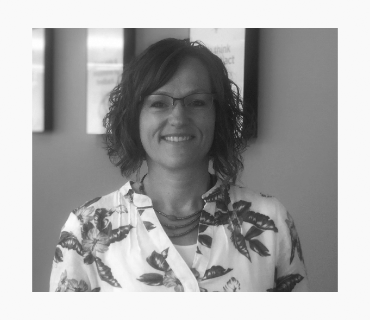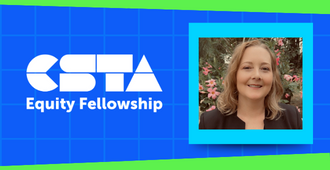
CSTA+ member Nicole Reitz-Larsen shares a bit of her story in being intentional in teaching computer science and the journey to making an impact.
Full Story
In February, our Membership Experience Manager, Cate Sauer, was able to speak with member Nicole Reitz-Larsen. Most recently, Nicole spoke at Silicon Slopes Tech Summit in Utah about inequity and barriers in computer science for teachers and students. She is a CS teacher, CSTA Utah chapter leader, CS advocate, and all-around superhero. Read more to find out how she advocates for herself, teachers, and her students for equitable access to opportunities in computer science.
Do you celebrate International Women’s Month in your classroom? I use posters from NCWIT.org to showcase to highlight in to show women in the industry and various careers. Females need to see themselves in computer science.
What advice do you have for members in regions where CS isn’t supported well?
Find a community, like a CSTA Chapter, an online forum, or other CS teachers that are in the same situation as yourself. Even with teachers that are unable to pay a membership fee, CSTA basic is a resource. CSTA+ plus members have access to opportunities for PD, and resources for the classroom. Teachers need to advocate for themselves. A lot of teachers do not consider themselves computer science teachers, but even if you only teach one class or support students with one program- you are a CS teacher.
Who is your role model?
I look up to Gail Chapman and Joanna Goode. They are extremely instrumental in promoting equity in computer science. Their teaching and curriculum didn’t cost me anything, and like many people, it has changed how I teach computer science. Their practices can be implemented in any subject.
Anything else you would like to share?
Open up your CS classes to all students. Also to remember as teachers we are and will be unsure of things we are teaching. Be an open learner. What does your day to day look like? My day starts at 4:15 a.m. with taking care of my kids, dogs, and myself. At 6:30 a.m. I’m arriving at school to open my computer lab, so kids have access to it before classes begin. Classes start at 7:30 a.m. go through 2:30 p.m., and I stay after school until 3:30 p.m. so students again can use the lab. Usually, after this, I have meetings or committees that focus on funding for CS at the local and state level. Then I do errands and support various sports activities for my kids. I’m also a facilitator in Utah for CS courses and Code.org, where I actually worked with Jake for CS Education Outreach.
 What kind of advocacy work have you done recently?
What kind of advocacy work have you done recently?
In January, I was at Silicon Slopes with a student of mine, Fifi Teklemedhin, where we participated in a fireside chat in front of 20,000 participants, with the former secretary of state Arnie Duncan talking about inequity and barriers in computer science for teachers and students.
Wow, what was that like for you and student at Silicon Slopes?
My student is an exceptional 10th grader, originally from Ethiopia, who has actually maxed out on available CS classes at our school. Actually, due to this, Pluralsight has helped in getting her more resources, as a company they are incredibly aware of issues in Computer Science in Utah and are advocates for teachers. At the event, she was so articulate, and actually was calmer and more collected then I was! I was able to address the barriers and inequities in computer science education that impact our students, which many in the industry and other organizations aren’t aware of or don’t understand.
What barriers do you see in computer science for teachers and students?
As a CS teacher, I have become more aware of the issues of gender and equity. For me, barriers include working with counselors and systems within a school, to encourage all students to be included in CS classes. It’s realizing that not all students have access to resources and computers at home. It’s realizing that the AP CS test costs $94 and some families cannot afford that, or visit a testing center, or would miss out on provided lunch if they are off-campus. It’s figuring out how to raise funds on how to get the students to a testing center.
What advice do you have for members interested in becoming advocates for computer science?
Many teachers, like myself, teachers get “voluntold” to teach computer science, and we need to support them. If you know of someone who is teaching CS for the first time or new to teaching it, share resources with them so that they can be successful and feel safe in their role. Help them find a local or online community (like CSTA!) to be part of so they can feel like they belong to the community and not in isolation. Look into how your school can get funding to support students and create a space where your class is a space of teamwork and collaboration. If test fees are an issue, find a business to help sponsor students’ fees. Be intentional about who you recruit so that your classes represent the general population of your school. Where can you get help for teachers? Find like-minded people who can help support you in making actionable changes. Network at conferences and with the local industry to find ways to support each other so that students see themselves in the cs field.
What resources do you use in your classroom to teach?
Pluralsight, which actually with your CSTA+ membership you get access to for free. Code.org, and CS4allteachers.org. It’s being intentional about projects and activities for different cultures. A curriculum I have used is Exploring Computer Science and the activity is called Cornrow Curves – it includes math, computer design, and programming.

 What kind of advocacy work have you done recently?
What kind of advocacy work have you done recently?

